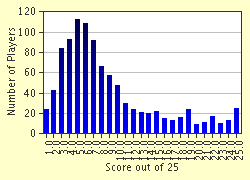Quiz Answer Key and Fun Facts
1. Jack The Ripper is credited with five murders, but, according to Scotland Yard, Jack The Ripper killed a total of nine women. What is the name of the first victim, from April 1888?
2. On Friday, August 31, 1888, George Cross was walking on his way to work when he discovered the body of Mary Ann "Polly" Nichols. In what area of Whitechapel was Nichols found?
3. What is the name of the doctor who was called to the first few murders?
4. Saturday, September 8, 1888, a woman was found in the backyard of 29 Hanbury Street, Spitalfields shortly after 6:00 A.M. What was the name of this woman?
5. On Monday, September 10, 1888, Detective Sergeant Thicke arrested a man who was known as Leather Apron. What was Leather Apron's real name?
6. On Thursday, September 27, 1888, a letter entitled "Dear Boss" was sent to the local news agency. What was the name of the news agency?
7. On Sunday, September 30, 1888 at 1:00 A.M., Louis Diemshutz was taking his pony cart to Dutfield Yard, off Berner Street in Whitechapel, when he noticed something on the ground. He lit a match, and was horrified to see the body of a women lying on the ground. Diemshutz immediately ran into the International Working Men's Educational Club for help. A member of the club went with him to look at the body. When they noticed blood all around the body, they both ran for help. What was the name of the woman whose body was found?
8. On Sunday, September 30, 1888, at 1:44 A.M., Police Constable Edward Watkins was walking his beat in Mitre Square when he came upon a woman lying on the ground, horrendously mutilated. What was the name of the woman whose body was found?
9. On Sunday, September 30, 1888, at 2:55 A.M., Constable 254A Alfred Long discovered a piece of bloody apron in the entrance way to a building on Goulston Street in Whitechapel. When Long shined his lamp, he noticed that a message was written in chalk on the wall. The message had a word that was misspelled. What was that word?
10. Who was the ground Inspector in charge of the case?
11. On Monday, October 1, 1888, a letter, in the form of a postcard, was sent to the local news agency, boasting of the double event of September 30th. What name was the letter given by the news agency?
12. In September 1888, after the second official Ripper murder, the Whitechapel Vigilance Committee was formed. Who was the head of this committee?
13. On Tuesday, October 16, 1888, a letter was sent to the head of the Whitechapel Vigilance Committee. What was the name of this letter?
14. On Friday, November 9, 1888, the day of the Lord Mayor's Show, Thomas Bowyer was sent to collect rent from 13 Miller's Court, in back of Dorset Street. Bowyer knocked a few times, and when no one answered, he pulled back the curtain inside the broken window. What he saw was so horrible that he would never forget it. Inside 13 Miller's Court was the grotesquely mutilated body of a young woman. What was the real name of this woman?
15. On Monday, December 31, 1888, the body of a man was found in the Thames River. The body was that of a schoolmaster who disappeared after the Miller's Court murder. What was the name of the man found in the river?
16. This suspect was a Polish Jew and lived in Whitechapel. He had a great hatred for women, especially prostitutes, and had strong homicidal tendencies. What was the name of this man?
17. On April 7, 1903, a man was hanged for poisoning his wife. The Inspector in charge of the Ripper case always believed this man was the Ripper. What was his name?
18. One of the most popular theories about Jack The Ripper has to do with the Royal Family. The grandson of Queen Victoria was known for visiting the slums of Whitechapel. What was the name of Queen Victoria's grandson?
19. Scotland Yard documents state that all the murders were committed by a left-handed person.
20. In 1992, Michael Barrett, a scrap metal dealer from Liverpool, claimed to have the diary of the man known as Jack The Ripper. What was the name of this man?
21. This suspect was a Russian doctor and a convict who was subsequently detained in a lunatic asylum as a homicidal maniac. His whereabouts at the time of the murders could never be proven. What was his name?
22. On May 23, 1892, this man was executed for the murder of his wife. While in prison, he claimed to be Jack The Ripper, although he was locked up during the Whitechapel murders. What was the name of this man?
23. In 1888 a man was arrested on homosexual activities. He was then put under suspicion of being the Whitechapel murderer. What was the name of this man?
24. According to another popular theory, Queen Victoria's Royal Doctor was Jack The Ripper. What was the name of the Queen's Royal Doctor?
25. Finish this everyday rhyme which is chanted in skipping games by children of the East End of London: "Jack The Ripper's dead, and lying on his bed. He cut his throat with _____________, Jack The Ripper's dead."
Source: Author
DakotaNorth
This quiz was reviewed by our editing team before going online.
Any errors found in FunTrivia content are routinely corrected through our feedback system.

